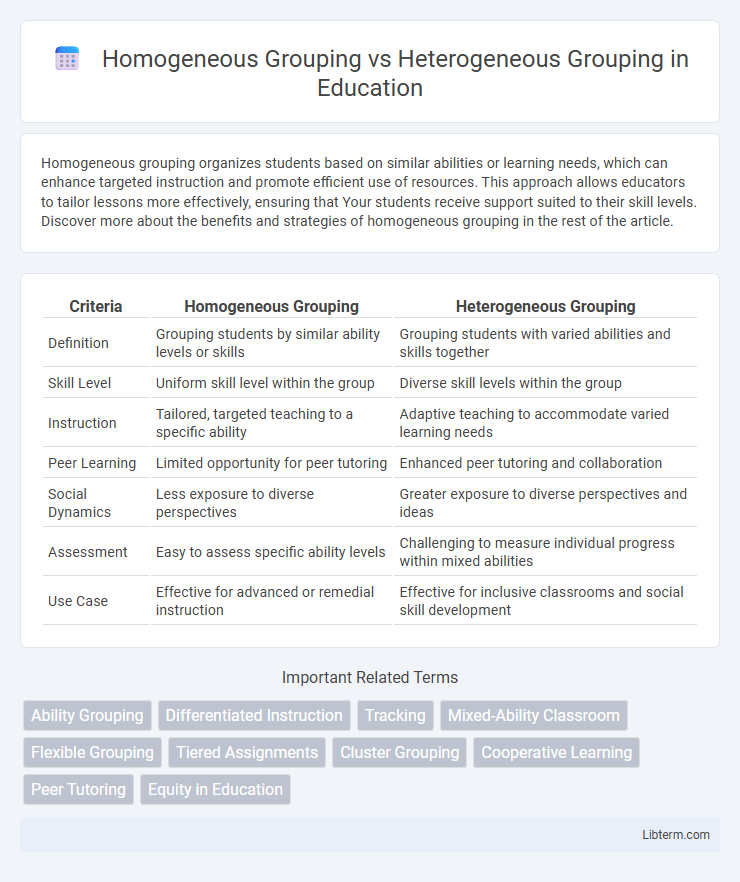Homogeneous grouping organizes students based on similar abilities or learning needs, which can enhance targeted instruction and promote efficient use of resources. This approach allows educators to tailor lessons more effectively, ensuring that Your students receive support suited to their skill levels. Discover more about the benefits and strategies of homogeneous grouping in the rest of the article.
Table of Comparison
| Criteria | Homogeneous Grouping | Heterogeneous Grouping |
|---|---|---|
| Definition | Grouping students by similar ability levels or skills | Grouping students with varied abilities and skills together |
| Skill Level | Uniform skill level within the group | Diverse skill levels within the group |
| Instruction | Tailored, targeted teaching to a specific ability | Adaptive teaching to accommodate varied learning needs |
| Peer Learning | Limited opportunity for peer tutoring | Enhanced peer tutoring and collaboration |
| Social Dynamics | Less exposure to diverse perspectives | Greater exposure to diverse perspectives and ideas |
| Assessment | Easy to assess specific ability levels | Challenging to measure individual progress within mixed abilities |
| Use Case | Effective for advanced or remedial instruction | Effective for inclusive classrooms and social skill development |
Understanding Homogeneous Grouping
Homogeneous grouping consists of clustering students with similar abilities or learning needs, which enhances targeted instruction and accelerates mastery of specific skills. This method allows educators to customize lesson plans effectively, leading to improved academic outcomes and reduced classroom distractions. Research indicates that homogeneous groups can boost student confidence by providing a supportive environment tailored to proficiency levels.
Defining Heterogeneous Grouping
Heterogeneous grouping involves organizing students with diverse abilities, backgrounds, and learning styles into the same group to promote peer learning and collaboration. This approach fosters a rich exchange of ideas, enhances social skills, and supports differentiated instruction by leveraging varied perspectives. Research shows that heterogeneous grouping can improve overall academic achievement and inclusivity in the classroom.
Key Differences Between Homogeneous and Heterogeneous Grouping
Homogeneous grouping organizes individuals with similar abilities, interests, or characteristics, enabling targeted instruction and faster skill development within a uniform learning pace. Heterogeneous grouping combines diverse members, promoting peer learning, collaboration, and exposure to various perspectives, which enhances critical thinking and social skills. The key difference lies in uniformity versus diversity, affecting instructional strategies, group dynamics, and educational outcomes.
Benefits of Homogeneous Grouping
Homogeneous grouping enhances targeted instruction by clustering students with similar abilities, allowing teachers to tailor lessons that match their skill levels and accelerate learning outcomes. This approach improves classroom management, as students often share common learning paces and interests, reducing distractions and fostering a focused educational environment. Furthermore, homogeneous groups facilitate more precise assessment of student progress, enabling educators to identify and address specific academic needs efficiently.
Advantages of Heterogeneous Grouping
Heterogeneous grouping fosters diverse perspectives, promoting critical thinking and problem-solving skills by bringing together students with varying abilities and backgrounds. This approach enhances social interaction and collaboration, preparing learners for real-world environments where teamwork involves different viewpoints. Research shows that heterogeneous groups improve academic achievement and equity by offering peer support and encouraging higher-order cognitive skills.
Challenges Faced in Homogeneous Grouping
Homogeneous grouping in classrooms often leads to challenges such as limited peer learning opportunities and reduced exposure to diverse perspectives, which can hinder critical thinking development. Students with similar skill levels may experience stagnation due to a lack of differentiated instruction that addresses individual strengths and weaknesses. Furthermore, homogeneous groups can amplify existing achievement gaps by isolating struggling learners from peers who could provide support and motivation.
Obstacles in Heterogeneous Grouping
Heterogeneous grouping often faces obstacles such as communication barriers stemming from diverse language proficiency and cultural backgrounds, which can hinder effective collaboration. Differences in academic abilities and learning styles may lead to uneven participation and potential conflicts within the group. Teachers must implement strategies to address these challenges by fostering inclusive environments and promoting mutual respect among group members.
Impact on Student Achievement
Homogeneous grouping often leads to targeted instruction that matches students' ability levels, potentially accelerating learning for both high-achieving and lower-performing students. Heterogeneous grouping fosters peer collaboration and diverse perspectives, which can enhance critical thinking and social skills but may require differentiated instruction to meet varied needs. Studies show that while homogeneous groups benefit skill mastery, heterogeneous groups promote deeper comprehension and interpersonal growth, impacting student achievement in distinct but complementary ways.
Grouping Strategies in Modern Classrooms
Homogeneous grouping clusters students with similar abilities, facilitating targeted instruction and enhancing focus on specific skill levels. Heterogeneous grouping mixes diverse learners, promoting peer collaboration, social skills development, and exposure to varied perspectives. Effective grouping strategies in modern classrooms balance these methods to address individual needs while fostering inclusive learning environments.
Choosing the Right Grouping Method
Choosing the right grouping method depends on the learning objectives and student diversity in the classroom. Homogeneous grouping clusters students with similar abilities to provide targeted instruction and accelerate skill development, ideal for remediation or enrichment. Heterogeneous grouping mixes varied skill levels to promote peer learning, collaboration, and diverse perspectives, enhancing social skills and critical thinking.
Homogeneous Grouping Infographic

 libterm.com
libterm.com